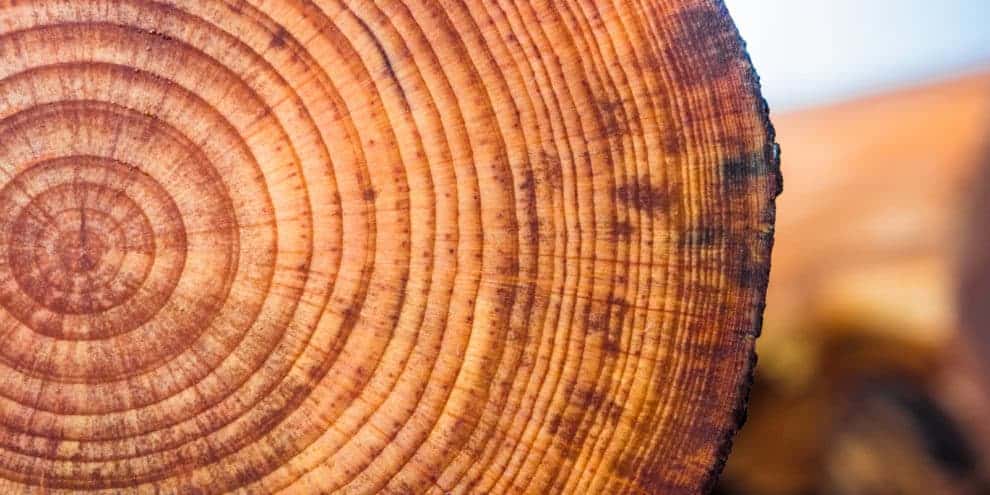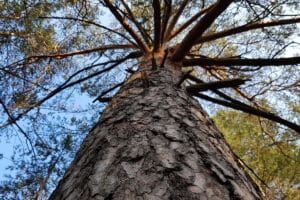Several individuals have contacted me in the last few weeks because they are interested in buying timberland for sale. That’s new. Are these signals of a turnaround? After all, they are quantitative evidence…of something.
The problem with investing in timberland right now is that precious little of it is priced as timberland, that is, land whose basic use is to produce and sell timber.
Timberland is priced higher than its timberland value because sellers have reclassified it for an economically “higher and better use (HBU),” namely as second homes. Where $500/acre might be the market price for timberland that’s used for producing timber, $2,000 an acre might be right for the same woods marketed as a homesite lot for sale to an urban buyer wanting a second home.
Part of the price difference has to do with pitching to different buyers, but the rest involves rebranding it and using the unchanged asset differently.
The price inflation that arises from a two-level market is more evident in smaller tracts of, say, 1,000 acres or less than larger one involving, say 10,000 acres or more. The timberland as timberland prices have edged up too, but not like the HBU conversions.
The large tracts are still for the most part being bought and sold by people who value this real estate mostly for its timber production and understand its pricing in those terms. HBU is, however, in the backs of their minds…and moving forward.
I’ve seen recently timbered tracts (with the next timber cutting 25 to 35 years in the future) priced at double or triple their bare land value. New England cutover is going for $800 an acre and up; one Michigan parcel of 80 acres of managed timberland was priced at $6,000 an acre; small tracts of southern pine land are priced at $2,500 an acre and up, with the emphasis on the up; West Virginia woods with limited timber value are $2,000 to $5,000 an acre depending how close they are to Baltimore, Washington or Pittsburgh.
Timberland that contains a lot of merchantable timber that can be sold immediately is worth more than timberland where the next harvest is 20 years out. But dirt-cheap cutover on a selective harvest may prove to be a better long-term investment than a parcel with 75 percent of its purchase price covered by the sale of merchantable timber. It depends on the price paid for each.
So my first bit of advice to timberland investors is don’t pay an HBU price for timberland if you want to keep it and use it primarily as timberland. The numbers will not work. The comps you will be shown are for HBU tracts, not timberland for timber production.
This market might eventually reset itself by dividing into its components as buyers refuse to pay an HBU price for timberland.
Timberland that’s bought at timberland prices has been an excellent investment, outperforming stocks since the 1960s. But that will end if buyers buy at HBU prices.
Small investors can still make money with properly bought timberland.
Timberland appreciation is driven by the following combination of factors:
- Background appreciation in land prices from population growth and continuing demand for wood products;
- Annual gain in tree height and diameter, which increases timber volume in all diameter classes (sizes); gain in volume is compounding;
- In-growth, which is the immediate increase in value as trees grow and move from a lower-value product category into a higher-value category. In a simplified example, hardwood trees have no timber value from, say, one to six inches in diameter; pulpwood value from six to, say, 12 inches; sawtimber value above 12; and possible veneer value above 18 or 20. At each change point, the value per unit (board feet, cords or tonnage) goes up several times over.
- Multiple-use timberland is likely to appreciate more than single-use timberland;
- Timberland usually has some environmental value that can be protected through the donation or sale of a conservation easement. A typical easement will preserve timberland as open space and for continued timber production, but prohibit or substantially limit division potential and improvements, such as residences. Sellers usually do not price CE value into their asking price, but buyers should calculate its possible monetary value, as well as its pros and cons, if the encumbrance of a CE is something that interests them;
- Certain types of timber and timberland will lend themselves to producing wood as an energy feedstock, such as the current market for pellets or a possible future market for cellulosic ethanol; product diversity can increase value of the timber resource;
- Timberland can be managed in a way to receive payment for CO2 retention;
- Some states extend land-use tax status to “managed timberland” that’s enrolled in a state program. This substantially reduces annual property tax, but may involve “strings” on the land’s sale and use.
- Rental/lease income from hunting and other recreational uses (cross-country skiing, horseback riding, mountain biking, ATVs, camping, etc.);
- Sale income from products, e.g., firewood, maple taps, ginseng, nuts, etc.;
- As federal policy backs out timber sales from public land, private timberland should increase in value owing to a shrinking national timber base;
- And…finally…HBU value at the time the landowner sells.
Timberland, of course, is subject to risk of loss from disease, pests, natural calamities (ice, wind, fire and drought), timber theft and troubles with natural regeneration post-timbering.
But the biggest problem from an investor’s perspective in my opinion, is the tendency to pay too much.
This content may not be used or reproduced in any manner whatsoever, in part or in whole, without written permission of LANDTHINK. Use of this content without permission is a violation of federal copyright law. The articles, posts, comments, opinions and information provided by LANDTHINK are for informational and research purposes only and DOES NOT substitute or coincide with the advice of an attorney, accountant, real estate broker or any other licensed real estate professional. LANDTHINK strongly advises visitors and readers to seek their own professional guidance and advice related to buying, investing in or selling real estate.










Good common sense article! I am a full time land broker with a +/-12 year background in timber/ land management, procurement and sales. When I began working in timber and land management in the early 1990’s, timber investors were controlling the land markets in the central part of Alabama. There was not a lot of demand for rural homesites or demand from the hunting and recreational users. Land prices, at that time, made sense for those wanting to purchase land for agricultural pursuits. However, we made a shift in the mid- 1990’s from an agricultural user land market to a homesite, mini-farm and recreational user market. Prices dramatically increased as demand for land grew along with the growth in these multiple use sectors of the market. The multi use market began to control land prices and the timber and agricultural buyers could only purchase land, that fit their investment model, in large acreage transactions; distress sale situations or by slipping under the radar and purchasing land from a owner that was willing to sell below the current market price- probably because they were unaware of the increase in demand and resulting price growth.
Our current economic situation has somewhat shifted market prices back in the direction of agricultural users. I have had a lot of senior friends tell me stories of individuals that created great personal wealth in the era of the Great Depression. These individuals had the means to purchase property, mainly land, when hardly anyone else could. They were able to buy it at a good price. I believe that the market is very, good in our area for capable investors to purchase land at a good, agricultural use, price. But, do not think that you are going to easily find good opportunities in print and internet ads. Most of the time, you are going to have to look below the surface. My definition of a capable investor is one that can purchase land that they can hold for at least five years without feeling pressured to bail out. I have always felt that you make a good investment at the time of purchase and not when you sell. You can control the purchase price much better than you can the sales price. Almost all property is going to sell at or near the current market value no matter how smart and savvy the seller is- or believes he/ she is.
Opportunities to buy land at a good price exist like no other time that I can remember. However, I have only been paying attention for +/-20 years.
Mr. Seltzer, I could not agree with you more about resisting any tendencies to pay too much for property. I believe you can defeat those tendencies by making an effort to do your homework and look below the surface a little. Also, I think that anyone that has ever considered investing in land would be foolish not to be paying attention to the opportunity that our economic troubles has created.
I disagree about being able to find land in print and internet ads. I am a real estate broker/owner of various rural parcels of land in Oregon and have successfully marketed land using both methods. “The market will bear what the market will bear” and it is much more global than ever before. Call me if you want info on current parcels in our inventory in Oregon 541-601-4374.
I have no idea what Ms. Copley is talking about when she says, “I disagree about being able to find land in print and internet ads.” The article says nothing at all about marketing timberland through either method, or both. I am, however, impressed that she disagrees with something that isn’t there.
She wasn’t replying to your article. She was replying the the previous comment/post by Brad Nolen.
This was very informative… thanks everyone 🙂
Good read. It explains what I’m seeing. I’m presently searching for property in Washington State. As I’m looking around, I’m seeing pricing that doesn’t make any sense. I had already begun to suspect exactly what you are saying, though I hadn’t come up with a name for it yet.
Thanks for the article!
Thank you for the reality check. I, for one, have felt like I’m taking crazy pills watching land prices and trying to make the numbers work for timberland. They don’t. Land prices are conforming to the greater fool theory. Therefore it is only a good investment at the going prices if the buyer can then find the greater fool when he’s ready to sell.
Long-term investing is the way to go! A wise man once said that anything worthwhile is worth a lot of work. Just because the timberland’s harvest is 20 years out doesn’t mean that the value of the land isn’t great. It means that it’s not great right now.
Do you think it’s possible there are properties in the US over 5000 acres where the trees are currently worth far more than the asking price?